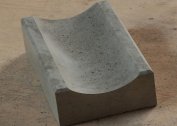A blockage in the sewer pipe is a household problem that often causes plumbing failures. This can only be avoided if the pipes are cleaned in a timely manner, and not necessarily with the help of a wizard. Now there are many independent ways to eliminate blockage, which, if used correctly, will solve the problem quickly and efficiently.
The main causes of blockages
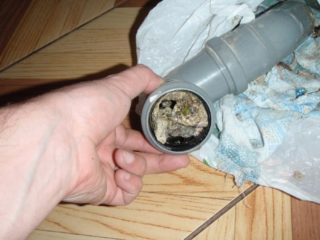 Excess household waste: hair, food debris, poor-quality detergents - these are the main causes of blockages. If you do not clean the sewer pipes from all this regularly, then there is a risk of clogging the sewer passages.
Excess household waste: hair, food debris, poor-quality detergents - these are the main causes of blockages. If you do not clean the sewer pipes from all this regularly, then there is a risk of clogging the sewer passages.
Plastic pipe clogging causes include improper installation and non-compliance with the required slope. In pig-iron pipes having high resistance to drains, clogging is formed due to corrosion, as a result of which sewage walls are overgrown with bloom.
Determination of the blockage
Most often, blockages occur at the bends and joints of the pipes, as well as in the places of their narrowing. To understand which section of the sewage system is clogged, you need to pay attention to the “behavior” of all plumbing. In the event that the water in the toilet, in the shower or bathtub freely flows into the drain, and in the sink, on the contrary, is delayed, then it is necessary to clean this area. A similar situation is with a clogged toilet. If water is standing in its bowl, while in the sink or bath passes quietly, then you need to do the cleaning of his system specifically.
Above we talked about local blockages, in addition to which there are others:
- Are common. In this case, the water does not leave two or more plumbing fixtures;
- Global. In this case, the water is in the drains at the same time of all plumbing fixtures that are installed in the house or apartment.
Clogging can be anticipated if you listen to the sound of water in the siphons of the sink. From there, after removing the cork, a characteristic gurgle will be heard. When it appears, you must immediately take up the cleaning of the sink, otherwise the situation threatens with a complete clogging of the sewer.
Chemical and mechanical methods of pipe cleaning
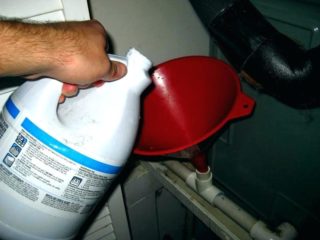 It’s not difficult to clean the sewer system with your own hands. To do this, you need to decide on the appropriate method - chemical or mechanical.
It’s not difficult to clean the sewer system with your own hands. To do this, you need to decide on the appropriate method - chemical or mechanical.
Chemical methods include eliminating blockages with household chemicals. They can be purchased in the department of the supermarket or made independently on the basis of soda.
Chemicals cope well with grease and soap deposits on the walls of pipes. Clog dissolution occurs due to the presence of alkali, acid and surfactants in such products. This method is less effective than mechanical, and can not cope with a strong blockage.
Chemical methods are simple and affordable. To clean the plumbing, special equipment is poured into the sewer system through a drain in the sink or bathtub. The time after which the blockage dissolves is different, because it all depends on the chosen chemical agent. Among the most famous are:
- “Mole” is a sodium hydroxide based product. It has a low cost and a fairly long time to eliminate blockage - 2 hours. It is better not to use it for cleaning plastic pipes, since there is a risk of material destruction;
- “Selena Antizasor” - a tool based on soda. Acts faster than what is described above - copes with blockages in an hour.
- Chirton “Clean Gutters” is a granular product based on soda and sodium nitrate.It costs more than Antizasor, but it takes only 15 minutes to clean the sewer.
Before using any of them, you need to take care of your own safety: put on gloves and ventilate the room well. Further instructions for using any of the listed tools is reduced to the following points:
- Pour or pour the right amount of funds into the drain hole;
- Pour 0.5 liters of water there;
- Wait as long as indicated on the packaging of the product used;
- Flush the sewer system with plenty of water (2-4 buckets);
In practice, it often turns out that household chemicals do not completely eliminate severe blockage, as a result, mechanical methods of cleaning pipes replace it. We will discuss them further.
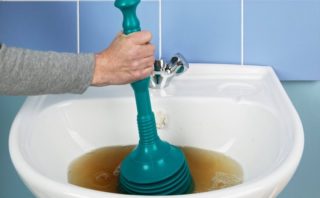 The main tools designed for mechanical cleaning of sewers include plunger and plumbing cable. The first copes well with small blockages, which are located close to the drain hole, while the second helps to solve deeper problems.
The main tools designed for mechanical cleaning of sewers include plunger and plumbing cable. The first copes well with small blockages, which are located close to the drain hole, while the second helps to solve deeper problems.
In order to qualitatively clean the clog with a plunger, it is necessary to follow the following instructions:
- Fill the plumbing with hot water so that the valve of the plunger, after installing it on the drain funnel, is completely under water;
- Now, holding the handle of the instrument with your hands, make a few vertical movements up and down. After the last pressure on the drain, sharply raise the valve of the plunger up above the water;
- Repeat several times.
The plumbing cable will cope with the clog that the plunger could not afford. By itself, this tool looks like a metal wire twisted into a spiral and taken into a plastic case with a handle. Use it as follows:
- Guide the cable into the drain hole and begin to unwind as it rotates or presses on the handle located on the tool body;
- When the end of the wire collides with a blockage, make a couple of reciprocating movements, pushing forward. As a result, the cork should go away;
- Pull out and rinse the cable;
- In conclusion, you can get rid of small debris with a bucket of hot water, which must be emptied into the plumbing drain.
To check the quality of the procedure, you just need to open the tap and see how the water flows into the drain. If everything happens instantly, the blockage is gone. If the water is still delayed, repeat the procedure.
How to choose a suitable method
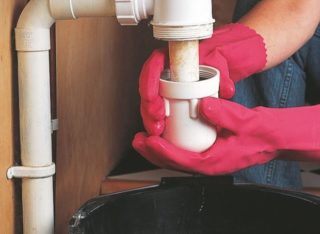 The choice of method for cleaning the sewer depends on the degree of clogging. Chemicals, as mentioned, will help cope with small garbage consisting of a small amount of household waste. Their use is appropriate for the clogging of the kitchen sink, which often contains food debris, as well as in the bath or shower, which can easily clog after washing your hair.
The choice of method for cleaning the sewer depends on the degree of clogging. Chemicals, as mentioned, will help cope with small garbage consisting of a small amount of household waste. Their use is appropriate for the clogging of the kitchen sink, which often contains food debris, as well as in the bath or shower, which can easily clog after washing your hair.
Mechanical cleaning methods are chosen for those blockages that chemistry cannot dissolve. For the most part, any item that has inadvertently got into the sewage system applies to such. In order to get it out of there, it is better to use a cable. A plunger is used if the chemical method is inactive. As experience shows, with a large accumulation of household waste in the sink, only this tool saves, regardless of the chemical used before its use.
Preventative measures
Reducing the risk of clogging will help control what gets into the sewer. For this purpose, a kitchen grate has already been installed in the siphon drain, but it will not be superfluous to install a special strainer filter in the drain of the kitchen sink. Thanks to him, food debris washed off during the washing of dishes will linger on the surface of the sink and will not fall into the pipes.
To prevent clogging of the toilet bowl, any water-insoluble debris should not be allowed to enter it.This includes rags forgotten in water after mopping, baby diapers and feminine hygiene items (pads, tampons). This is the only way in the sewer system of the bathroom to avoid clogging.
In addition, it is recommended that you clean the pipes every 2 weeks with chemicals. Thus, small blockages do not have time to transform into large ones, and there will be no problems with plumbing.
As it turned out, cleaning the sewer system of your house or apartment yourself is not as difficult as it seems at first thought. However, in order to prevent serious damage, it is better to carry out preventive measures. Otherwise, you still have to turn to specialists for help.


